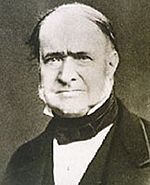Jean-Baptiste Élie de Beaumont facts for kids
Quick facts for kids
Léonce Élie de Beaumont
|
|
|---|---|

Léonce Élie de Beaumont
|
|
| Born | 25 September 1798 |
| Died | 21 September 1874 (aged 75) Canon, Calvados
|
| Nationality | French |
| Alma mater | École des mines |
| Awards | Wollaston Medal (1843) |
| Scientific career | |
| Fields | geology |
Jean-Baptiste Armand Louis Léonce Élie de Beaumont (born September 25, 1798 – died September 21, 1874) was a famous French geologist. He spent his life studying the Earth and its mountains.
Contents
A Life Dedicated to Geology
Léonce Élie de Beaumont was born in a town called Canon in Calvados, France. He was a very bright student from a young age.
Early Education and Studies
He went to the Lycee Henri IV school, where he won top awards in mathematics and physics. Later, he attended the École polytechnique, a top engineering school. He finished first in his class in 1819. He then studied at the École des mines from 1819 to 1822. It was there that he found his passion for geology.
Learning from the Best
In 1823, Léonce Élie de Beaumont was chosen for an important trip. He went with another geologist, Dufrénoy, and their professor, Brochant de Villiers. They traveled to England and Scotland. Their goal was to learn about mining and how to create geological maps. They studied a map made by George Bellas Greenough to help them make a similar map of France.
A Leading Geologist in France
Léonce Élie de Beaumont became a geology professor at the École des Mines in 1835. He had been helping his old professor since 1827. He also held important roles in mining in France. From 1833 to 1847, he was the chief engineer of mines. Later, he became the inspector-general. In 1861, he was made vice-president of the General Council of Mines.
His work was recognized by many important groups. He became a member of the Prussian Academy of Sciences, the French Academy of Sciences, and the Royal Society of London. In 1853, he became the permanent secretary of the French Academy of Sciences.
Understanding Earth's Mountains
One of Léonce Élie de Beaumont's most famous ideas was about how mountain ranges are formed. He first shared his theory in 1829. He later wrote a detailed book about it called Notice sur le système des montagnes (Notice on the System of Mountains).
His Mountain Theory
He believed that all mountain ranges that run parallel (side-by-side) to the same large circle on Earth were formed at the same time. He also thought there was a special pattern, like a five-sided network, in how these circles related to each other.
His theory was discussed by other geologists, like William Hopkins. While his exact theory was not fully accepted by everyone, it was still very important. Why? Because to try and prove his idea, Léonce Élie de Beaumont studied many mountain ranges. This led to a lot of new information about how mountains are built.
Mapping France's Geology
Perhaps Léonce Élie de Beaumont's greatest contribution was his work on the geological map of France. He played a main role in creating this detailed map. While working on it, he published many important papers about France's geology. He continued to oversee the map's publication almost until he passed away. His lectures from 1843-1844 were also published as a book called Leçons de Géologie pratique (Lessons in Practical Geology).
Mount Elie de Beaumont
There is a mountain named after him! Mount Elie de Beaumont is located in Westland Tai Poutini National Park in New Zealand. It is on the west coast of New Zealand's South Island. This tall mountain stands at 3,109 meters high.

